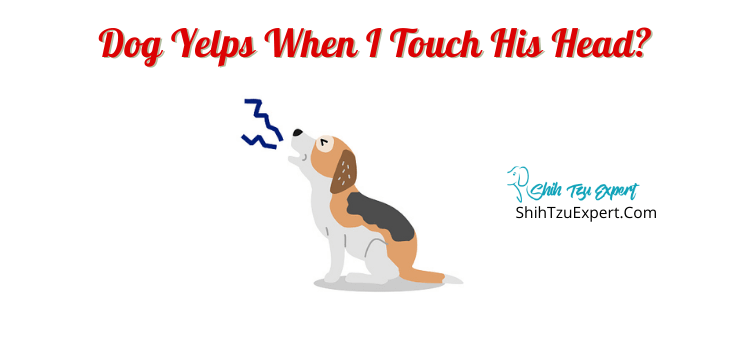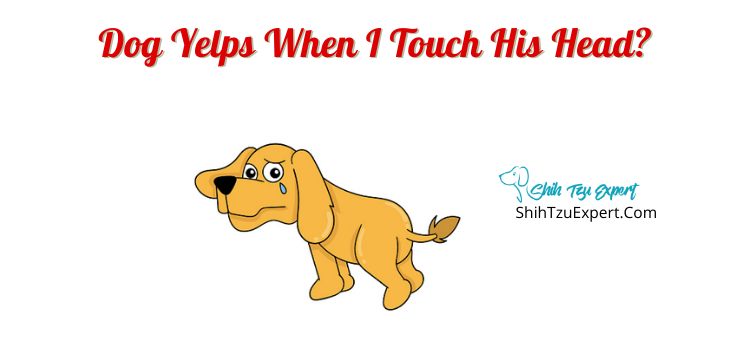Yelping or crying in dogs can be very concerning. Of course you want to make sure your dog is healthy and not in pain. This article will help pinpoint why your dog is yelping and crying when touched.
Dog Yelps When I Touch His Head?
Dogs can yelp or cry for many reasons. They may be excited or anxious. They might also be in pain. Depending on where in the body they are being touched when they yelp, this may be serious. Determining why your dog is yelping is critical so you can address it by either helping the dog feel less afraid or calmer or by treating the cause of the pain. In many cases, you will need to contact your local veterinary office to speak with a medical professional in order to know how to help your dog. In some cases, your dog may need to be treated by your vet.
Keep your dogs safe, healthy, and happy by making sure any causes of pain are addressed as soon as possible.

Why Does My Dog Yelp And Cry When I Touch Her?
Dogs yelp for many reasons. This article will help you figure out why your dog is yelping and crying. Yelping can be a sign of your dog being in pain so it is very important to learn what is going on for your dog.
While it may be concerning if your dog suddenly begins to yelp or cry when you touch her, there are many reasons for this behavior besides injury or pain. It is important to ensure your dog is not experiencing any physical discomfort. After you are sure there is no cause for alarm, you can consider other reasons your dog may whimper or cry when you touch her.
Some reasons your dog may whimper or cry when you touch her even though she is not in pain:
- Excitement
- Fear
- Stress
- Anxiety
If your dog has recently experienced a traumatic event, she may be stressed and therefore whimper or cry when you touch her. Your dog may also experience anxiety if there is a new person around or if a person is being overbearing and not respecting your dog’s boundaries. If you have been on a long trip without your dog, she may whimper or cry with excitement when you return.
If your dog is yelping out of excitement, this may be okay. However, if the yelping and crying is accompanied by behavioral issues not linked to any physical condition, you may need to seek help from a trainer. The earlier a behavior is addressed, the more likely it is to be resolved and the bad habit broken. A dog trainer can teach you to gently correct your dog’s behaviors so that your relationship with your dog is strengthened, and you can help your dog learn where her boundaries are. Teaching a dog boundaries will help her live a happy and fulfilled life with you!
Dog Cries When I Touch His Mouth?

Your dog may cry or yelp when you touch his mouth due to pain. The pain may be caused by a tooth infection or even a tumor causing swelling on the gums. If your dog continues to cry or yelp when you touch his mouth, seek veterinary care.
Signs your dog may be experiencing dental issues:
- Bleeding gums
- Inflamed or reddish gums
- Bad breath
- Brown or yellow discolored teeth
- Loose or missing teeth
- Irritability
- Excessive drooling
- Weight loss
- Reduced appetite
- Blood on chew toys or water bowl
- Bloody saliva
- Problems keeping food in mouth when eating
- Favoring one side of their mouth
When bacteria builds up in your dog’s mouth, plaque eventually forms. Eventually, this hardens and turns to calculus which is very hard to remove from their teeth. Gums can become inflamed as a result of this build-up. This causes gum disease. Additionally, poor nutrition and diet can play a role in the development of gum disease which can then result in gum disease, causing pain in your dog’s mouth.
Gum disease and plaque can occur from poor grooming habits like your dog licking himself too frequently, alignment of his teeth, unclean toys, or all of the above.
You can prevent gum disease, or periodontal disease, by being proactive in your dog’s oral hygiene. Your dog should see a vet every 6 months for an oral evaluation. You can brush your dog’s teeth daily to avoid buildup. You can also have your dog’s teeth professionally cleaned at their checkups. Dogs can use dental chews to help keep their teeth clean and prevent any issues springing up between vet visits. However, dental chews are not a replacement for brushing your dog’s teeth.
If you suspect periodontal disease in your dog, schedule a visit with your vet. They can help you address the issue and advise you on the best way to treat and prevent any irritation.
Preventing and treating periodontal disease in your dog should address any yelping or crying associated with touching his or her mouth.
Dog Yelps When Touched Behind Ear?
Your dog may help when touched behind or near his ear due to an inner or middle ear infection. Ear infections in dogs are the most common type of infection. Ear infections can typically be easily treated by your vet. Schedule an appointment as soon as possible because these infections can be very painful for your dog.
Dog Yelps When Touched On Side Of Face?
Your dog may be yelping when touched on the side of the face for a few reasons. Your dog may be experiencing gum or tooth issues or there may be a tumor in or around the mouth area. Also, there may be swelling in the area which causes the area to be tender and sensitive to touch. Only a vet can run the tests necessary to conclude what is causing your dog discomfort. If this behavior continues, seek professional help.
Dog Sensitive To Touch On Lower Back?
If your dog is sensitive to touch on the lower back, moving away or yelping or crying when touched, they may be in pain due to a condition called “horse’s tail.” This condition is also referred to as cauda equina syndrome or lumbosacral syndrome. This is a condition in which the lower spinal canal narrows resulting in the compression of the spinal nerve roots. This can occur when your dog has arthritis, intervertebral disc herniation, an infection, a malformation, or a spinal tumor. Only a veterinarian can diagnose this condition.
Additional signs of lumbosacral syndrome:
- Falling to knees if tail is lifted
- Resist standing up
- Slow to stand after laying down
- Weakness or lameness in hind legs
- Fecal or urinary incontinence
- Persistent chewing on feet or tail to the point of injury
When visiting your vets, they may use an X-Ray to diagnose lumbosacral syndrome, though x-rays can be inconclusive. An additional screening called myelogram may be performed to provide more conclusive results. CT scans and an MRI may also be used to help diagnose lumbosacral syndrome.
Depending on the severity of lumbosacral syndrome, it can be treated medically or surgically. Surgeries can be very costly so treatment also depends on the preference of the dog’s owner.
Following treatment, the dog will be required to rest. Strict rest is essential for a full recovery after a back injury.
Dog Yelps When Touched On Back End?
When your dog yelps when she is touched on her back end near her tail and legs, it can be a sign she is in pain or may have been startled. Especially as a dog ages, it may become easier to startle if they do not hear you or see you coming. If your dog is in pain, it will often display other signs of distress.
Signs of distress in dogs:
- Restlessness
- Change in sleeping habits
- Loss of appetite
- Excessive licking
- Biting, growling, or other aggressive behavior
- Desires more or less than usual amounts of affection
- Heavy breathing
- Arched back while tucking tail
- Trembling
Dog Yelps When Touched On Side?
As with most yelping, if your dog yelps when touched on the side, it could be from pain, excitement, or fear. As previously mentioned, yelping from pain typically comes with other signs of distress. Depending on where on the side you are touching, yelping from pain may be serious. When dogs play hard, they can bruise ribs, break bones, or otherwise injure themselves. Determining if your dog is in pain is crucial. Monitor the areas that when touched result in yelps. Notice if they get better or worse over the course of a few hours or days depending on severity. Report to your vet any changes in behavior in relation to your dog’s yelping.
Dog Yelps When Touched On Left Side?
Typically, a dog’s bladder sits on the lower left side of its belly. If your dog yelps or cries when you touch around that area of his body, he may have a bladder infection or issues with urination. However, the exact location of the organs in that area of the body can only be determined by a trained professional. Only a vet can confirm that your dog’s discomfort is being caused by the bladder.
Other signs your dog may have a bladder or urinary tract infection:
- Excessive urination
- Excessive drinking
- Foul-smelling urine
- Diarrhea
If you suspect your dog has a bladder infection or a UTI, contact your veterinarian. A urinalysis and exam will be necessary to evaluate the condition of your dog.
Dog Yelps When Barely Touched?
If your dog yelps and tries not to move when you touch its head, this may be a sign your dog is in pain. If your dog is in pain, you will notice stiffness. He will try to only move his eyes without moving the rest of his head or neck while trying to look at you.
First, determine if your dog is in pain. If he is not, consider that your dog may be communicating with you about something else. Maybe he was startled. Maybe he is excited to see you. Maybe he is bored and frustrated and needs more mental stimulation and play. Maybe you have the type of dog that is very verbal and uses many sounds to communicate with you. He could want your attention or want food or water.
If you are interacting with a new dog that is not yours, and they yelp or cry when you touch them, they may not like your attention. Some dogs are fearful of new people or are anxious when they meet someone for the first time. Give the dog some space, and ask their owner if this is usual behavior. Then ask what would help the dog feel most comfortable. The owner may say something like, “Just ignore her and look away. She will approach you when she is ready to say hello.”
You should always follow the instructions of a dog’s owner especially when the dog is showing signs they may be nervous or afraid of you.
Dog Suddenly Sensitive To Touch?
Dogs who are suddenly sensitive to touch are likely injured. This is the surest way to know your dog might be in serious pain. Notice if your dog whimpers or cries when you touch just one area of the body. If he does, that is likely the area in pain. If he whimpers while you touch all areas of his body, he may have an upset stomach, or it may be caused by pain in his internal organs.
Additional signs of infection included change in stool, vomiting, sluggishness or lethargy, and diarrea. If you suspect your dog has an infection, please contact your vet immediately.
References
https://vcahospitals.com/know-your-pet/lumbosacral-syndrome-in-dogs

![Shih Tzu Poodle mix [Your complete guide to Teddy bear dog | Shih Poo | Shoodle or Pooshi] Shih Tzu Poodle mix [Your complete guide to Teddy bear dog | Shih Poo | Shoodle or Pooshi]](https://shihtzuexpert.com/wp-content/uploads/2020/06/Are-You-a-Good-Match-for-a-Shih-Poo.jpg)
![Custom shape wireless dog fence [Electric Fencing and Electric Barrier Systems] Custom shape wireless dog fence [Electric Fencing and Electric Barrier Systems]](https://shihtzuexpert.com/wp-content/uploads/2019/07/Custom-Shape-Wireless-Dog-Fence-Review.png)

